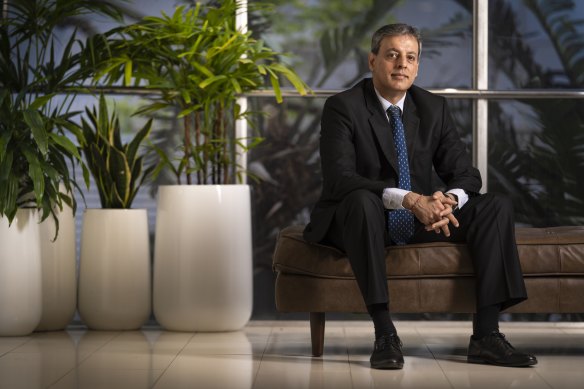By Nick Toscano
When Sanjeev Gandhi took over as chief executive of explosives maker Orica, he was faced with a “perfect storm”: COVID-19 was forcing major customers in the mining sector to curtail production, China had slapped a ban on Australian coal, and supply chains everywhere were grinding to a halt.
Fast-forward to 2022 and dark clouds are gathering once again for the Melbourne-based manufacturing giant, with the war in Ukraine, a global energy crisis and inflation throwing up a new set of challenges.

Sanjeev Gandhi’s strategy is starting to gain traction.Credit: Eamon Gallagher
“In the worst-case scenario, the global economy is going into a recession with high inflation and interest rates,” says Gandhi.
Recessions are bad news for businesses like Orica, whose fortunes rise and fall on how much demand there is for explosives and blasting systems from the mining, quarrying and construction sectors.
This time, however, the ASX-listed company considers itself better-equipped for the threat of external shocks. “We have done a good job of building resilience,” says Gandhi. “Our strategy has started to take shape.”
Becoming a more resilient business has been a point of focus for Gandhi and his team at Orica, whose operations span 100 countries and employ 13,000 people. Last year, Gandhi lifted the lid on a significant strategy refresh, telling shareholders Orica will seek to increase its offerings, attract new customers in Asia, and – perhaps most importantly – extend its reach into so-called “future-facing” commodities.
Copper, cobalt, lithium and nickel – these are metals the world urgently needs more of to build electric cars and clean energy infrastructure to meet accelerating global decarbonisation targets. Greater supplies of these commodities will have to come from somewhere, and the reality is most will have to be mined from increasingly deeper underground.
Gandhi is pushing to position Orica’s mining technology products and growth plans accordingly. The results are beginning to show.
Copper – an essential material needed to build electric wiring and electric vehicles – has now become Orica’s single biggest commodity exposure, according to the company’s latest full-year results.
And in August, it sealed a $260 million takeover of Western Australia-based Axis Mining Technology, which designs and manufactures specialised geospatial tools and instruments for the mining industry, as part of a bid to enhance Orica’s ability to enable customers to access deeper deposits of “future-facing” minerals in more difficult geographies.
“In the megatrends of electrification and connecting grids, batteries, wind and solar power ... all of that needs copper,” says Gandhi, who spent 26 years with German chemical company BASF before joining Orica. “That’s part of our strategy, focusing on what we call future-facing commodities, products that will enable the world to become more sustainable.”
More and more, the world’s biggest mining companies are steering their strategies towards copper, too. Just last week, BHP struck a $9.6 billion deal to take over South Australia-based copper producer Oz Minerals.
Rio Tinto, meanwhile, is pressing ahead with a $US3.3 billion ($4.9 billion) deal to take full control of Toronto-listed Turquoise Hill Resources to lift its exposure to the Oyu Tolgoi copper and gold mine in Mongolia.
As well as expecting strong ongoing demand growth from future-facing metals, Gandhi believes Orica is in an advantageous position to be able to weather global economic headwinds because of its exposure to other counter-cyclical businesses: its number-two commodity is gold, which is widely used as a “safe haven” for investors to store wealth during times of political and economic uncertainty.
After sinking to a net loss of $174 million in 2021, Orica returned to a $60 million profit in the year to September 30. Orica’s underlying earnings of $579 million, underpinned by higher sales of ammonium nitrate and electronic blasting systems, marked an increase of 36 per cent from the prior year, beating analysts’ forecasts. The company has guided investors to expect higher earnings in the 12 months ahead amid solid demand growth from the mining industry and continued “commercial discipline”.
Still, Gandhi, like chief executives everywhere, is readying for tough times in the global economy persisting. One of his top concerns is the soaring price of gas and electricity, which may flow through to Orica’s customers and dampen demand. Orica itself also heavily depends on gas, as it is the key input in ammonia nitrate. Although the company is not presently in the market for new supply agreements, Gandhi says east-coast spot prices, which have more than doubled to beyond $20 a gigajoule, are wholly unsustainable.
The Albanese government is debating a range of potential interventions in the gas market to tame runaway energy costs, such as introducing price caps on local gas sales and stronger limits on how much gas can be shipped offshore as liquefied natural gas (LNG) overseas.
While gas producers are pushing back against the looming threat of intervention by warning it could imperil investments in future sources of supply, Gandhi says he is grateful for the federal government’s efforts to tame runaway prices, and is hopeful “there might be a solution coming up”.
“I don’t think there is anyone in this country that can afford gas at $20-plus,” he says. “We need to find a way to temper that and make it a bit more reasonable for consumers.”
The Business Briefing newsletter delivers major stories, exclusive coverage and expert opinion. Sign up to get it every weekday morning.